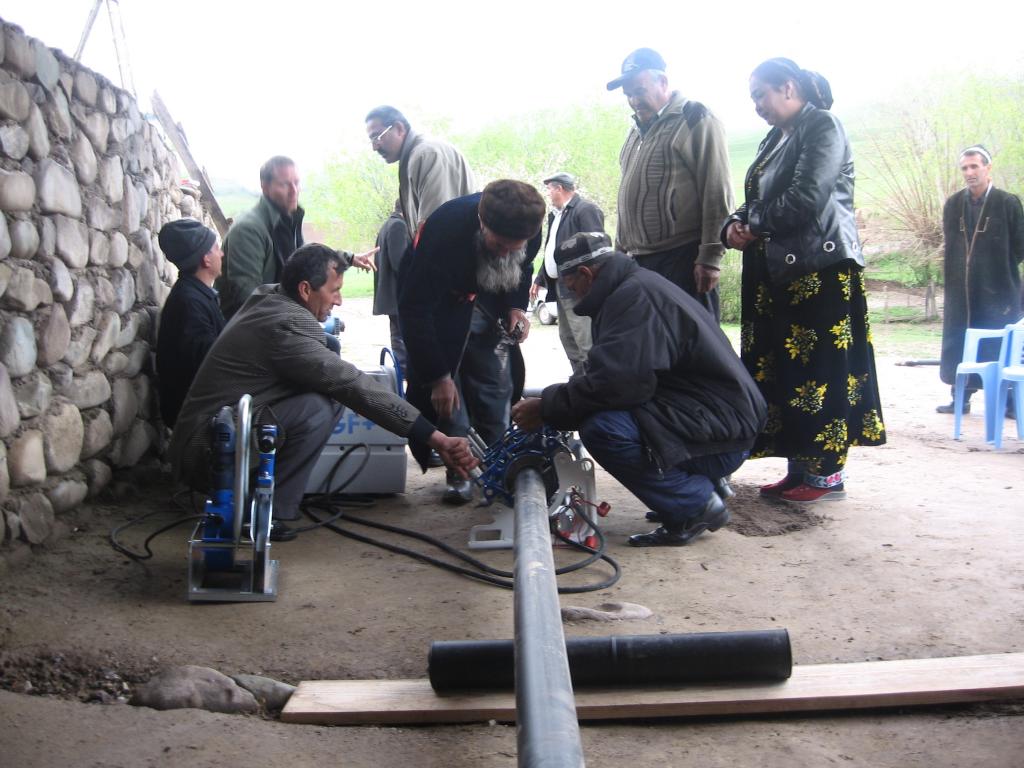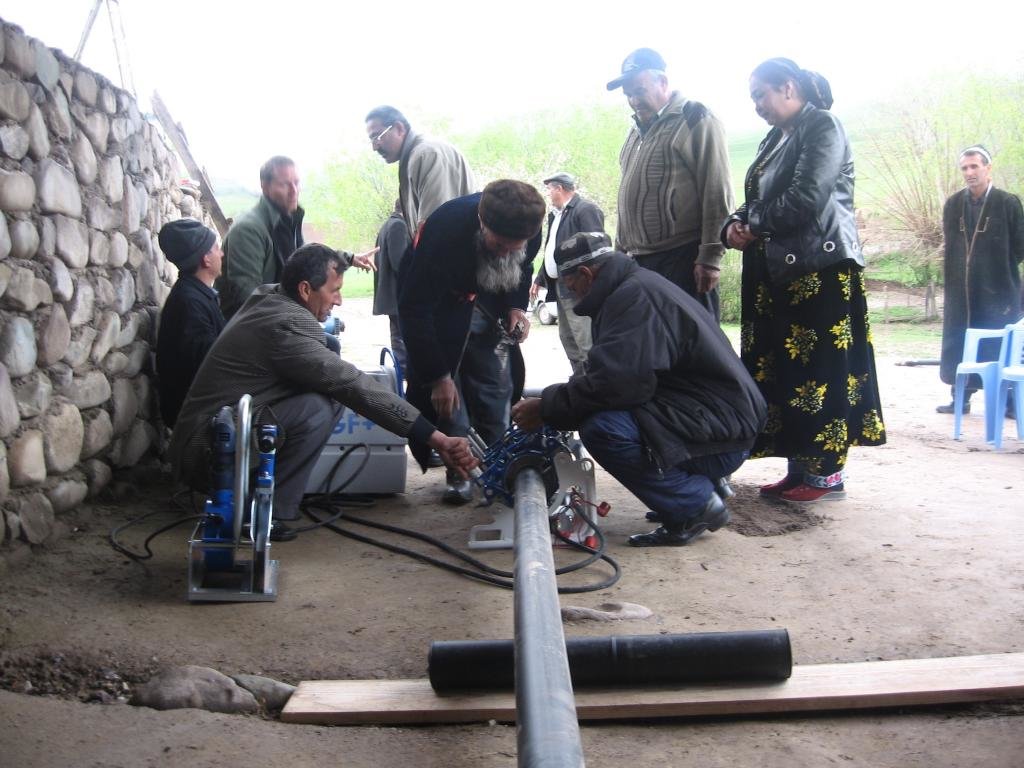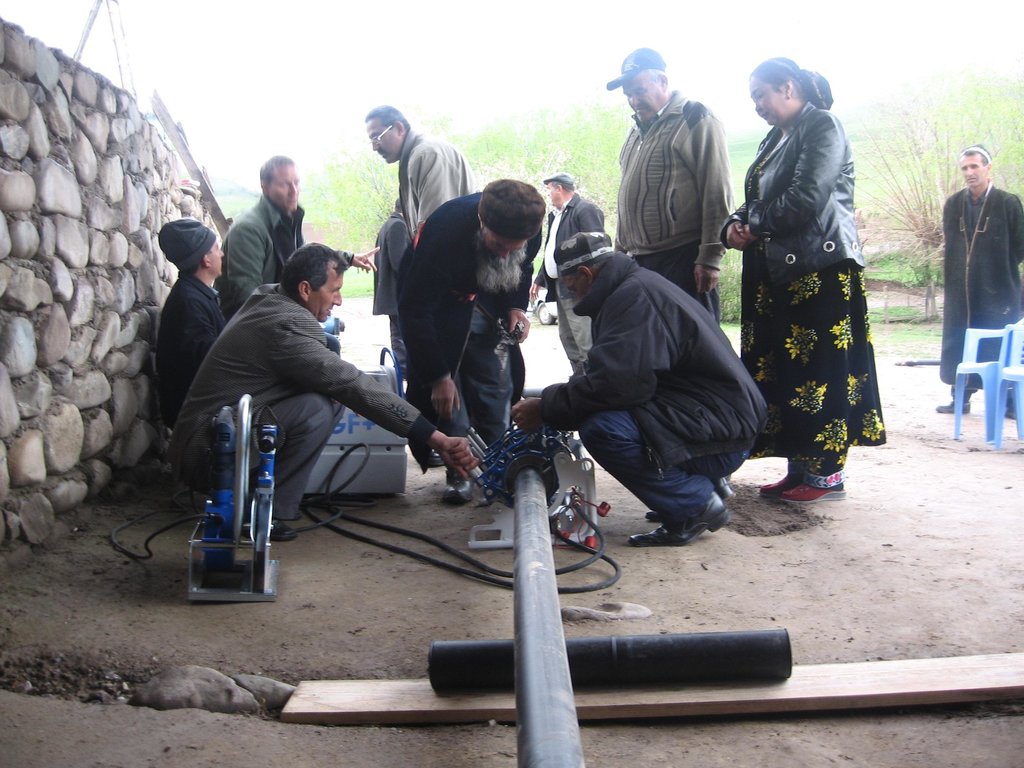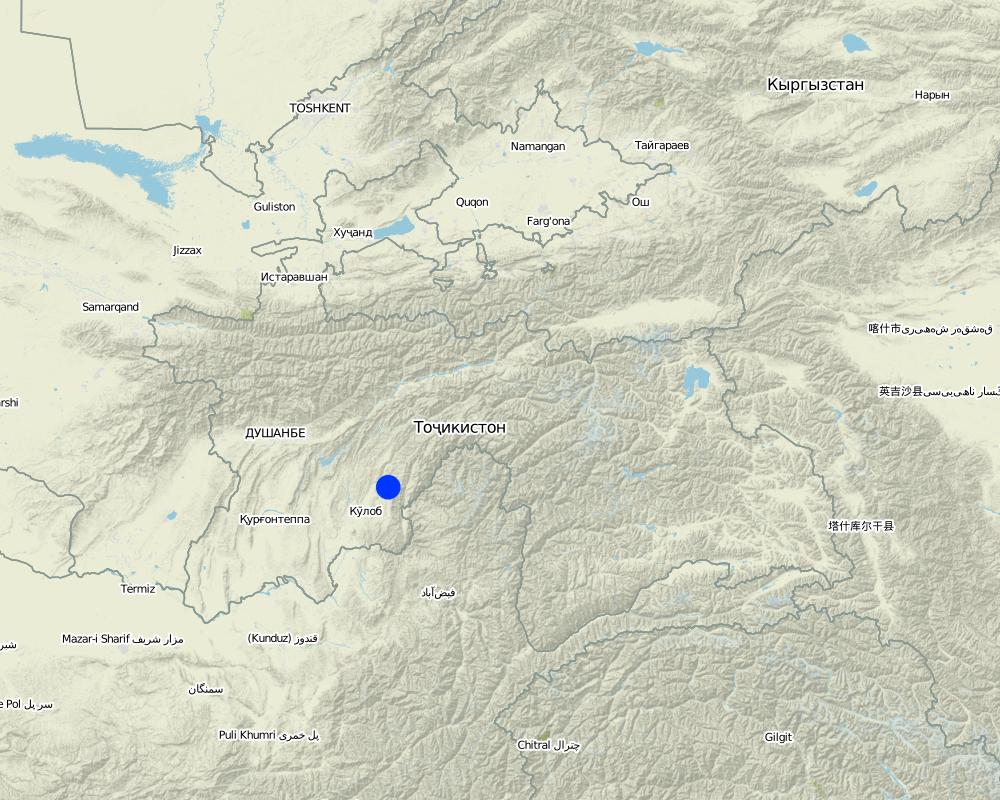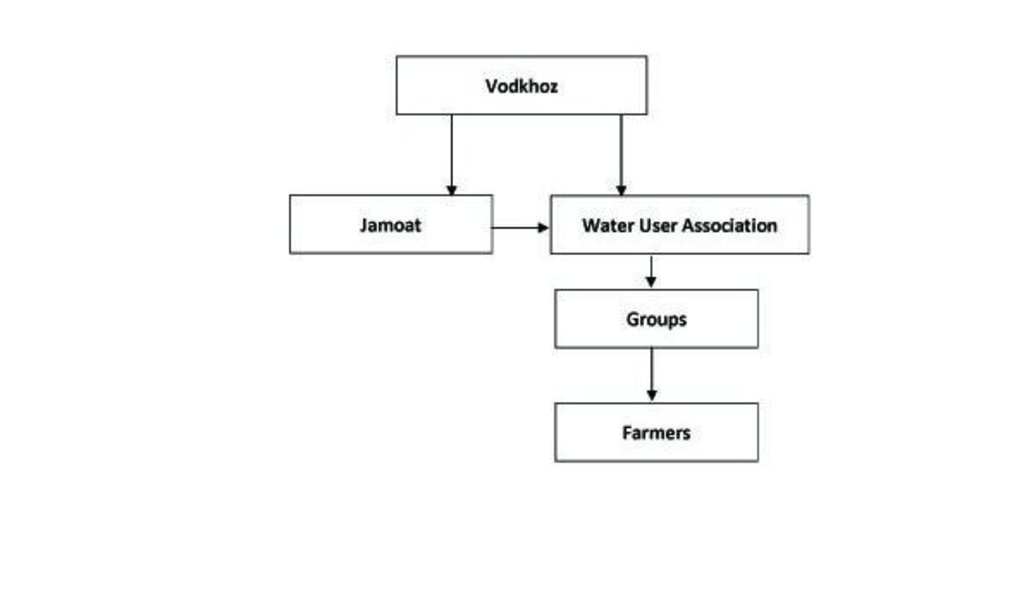Water User Association [Tajiquistão]
- Criação:
- Atualização:
- Compilador/a: Sa'dy Odinashoev
- Editor: –
- Revisor: David Streiff
Ассотсиатсияи Истифодабарандагони Об
approaches_2458 - Tajiquistão
Veja as seções
Expandir tudo Recolher tudo1. Informação geral
1.2 Detalhes do contato das pessoas capacitadas e instituições envolvidas na avaliação e documentação da abordagem
usuário de terra:
Kassirov Gayur
WUA
Tajiquistão
Nome da(s) instituição(ões) que facilitou(ram) a documentação/avaliação da Abordagem (se relevante)
CARITAS (Switzerland) - Suíça1.3 Condições em relação ao uso da informação documentada através de WOCAT
O/a compilador/a e a(s) pessoa(s) capacitada(s) aceitam as condições relativas ao uso de dados documentados através da WOCAT:
Sim
2. Descrição da abordagem de GST
2.1 Descrição curta da abordagem
Management and control of the water distribution, maintenance of the infrastructure and water conflict resolution by the locally organized association
2.2 Descrição detalhada da abordagem
Descrição detalhada da abordagem:
Aims / objectives: Under the National land reform of the Republic of Tajikistan, land resources, which used to belong to kolkhozes and sovkhozes, were distributed to individual households. Such division had two consequences, on the one hand, villagers were given opportunity to develop the land privately as an income-generating source, and on the other hand, it intensified the conflicts over water. The government was not capable to solve the disputes over water and manage the water resources sustainably because of lack of finances and lack of staff. A water users association was created with the aim to replace the former Soviet water management system and to ensure systematic and timely distribution of irrigation water and maintenance, as well as to improve the infrastructure.
Methods: This approach involves thee different actors: association members (water users), the association and the government. The association members have to stick to certain conditions in order to join, namely, they have to pay annual membership fees and water taxes fixed by the government. Government, on its turn, ensures uninterrupted supply of the agreed amount of water and the association is responsible for the control and equal water distribution and all related technical works.
Stages of implementation: Steps involved in creation of the water users association.
1) Local leaders met with representatives of Vodhoz (local state agency, regulating water resources) to discuss creation of an independent association with a full mandate over irrigation water management; 2) Leaders organized a general meeting with people of 5 villages in Muminabad district to inform them about the role and importance of establishing a locally based association and discuss conditions for its membership; 3) Charter of the association was developed, 5 leaders representing villages were elected and the amount of a membership fee was agreed upon; 4) The association was registered as a legal entity; 5) Needed amount of water per growing season was calculated and agreed upon; 5) The Leaders (of association?) and Vodvoz concluded an agreement, according to which, Vodhoz is obliged to provide the required amount of water and the association leaders agree to collect the determined fees for water from the water users and to deliver it on time to Vodvoz.
Role of stakeholders: The role of the three main stakeholders (Vodhoz, association and water users) is to follow the rules of the association. There is a strong element of trust among the association and its members.
2.3 Fotos da abordagem
2.5 País/região/locais onde a abordagem foi aplicada
País:
Tajiquistão
Região/Estado/Província:
Khatlon
Especificação adicional de localização:
Muminabad
Comentários:
270 ha
Map
×2.6 Datas de início e término da abordagem
Indique o ano de início:
2010
2.7 Tipo de abordagem
- Iniciativa/inovação local recente
2.8 Principais metas/objetivos da abordagem
The Approach focused mainly on SLM with other activities (regulation of water distribution, water conservation, conflict resolution)
To establish a responsible body, recognized by the government and accepted by the local people, to manage water related issues and to maintain as well as to improve conditions of the infrastructure in the local level.
The SLM Approach addressed the following problems: The approach is addressing the problem connected with the use of the water resource. Incapability of the government to manage waters on the village level resulted in conflicts over water use, misusage of water and abundance of the infrastructure. This condition had a direct effect to productivity and to food security as a consequence.
2.9 Condição que propiciam ou inibem a implementação de tecnologia/tecnologias aplicada(s) segundo a abordagem
Disponibilidade/acesso a recursos e serviços financeiros
- Inibitivo
No funds available to maintain the infrastructure
Treatment through the SLM Approach: Annual membership fees
Quadro institucional
- Inibitivo
No strong and effective mechanism to regulate irrigation water resources at the local level.
Treatment through the SLM Approach: Establishment of the water users association at the local level and respresented by local people.
Quadro jurídico (posse de terra, direitos de uso da terra e da água)
- Inibitivo
Unclear situation with regard to water use rights and obligations.
Treatment through the SLM Approach: The condition that association was represented by the local leaders enlarged the trust among the population. During the general meetings local leaders of the association explained for what villages are paying and where money would be invested.
3. Participação e papel das partes interessadas envolvidas
3.1 Partes interessadas envolvidas na abordagem e seus papéis
- Usuários de terra/comunidades locais
Association leaders
- Especialistas em GST/ consultor agrícola
- Governo nacional (planejadores, responsáveis pelas decisões)
Water Agency/VODHOZ
Caso várias partes interessadas foram envolvidas, indique a agência líder:
Association leaders
3.2 Envolvimento do usuários de terra/comunidades locais nas diferentes fases da abordagem
| Envolvimento do usuários de terra/comunidades locais | Especifique quem estava envolvido e descreva as atividades | |
|---|---|---|
| Iniciação/motivação | Participativo | It was members of the local community, who thought of the idea and they approached the local water agency. |
| Planejamento | Participativo | Local leaders organized the meeting where all interested villagers participated. |
| Implementação | Apoio externo | Implementation was entirely through the local community. |
| Monitoramento/avaliação | Nenhum | |
| Research | Nenhum |
3.3 Fluxograma (se disponível)
Descrição:
Organizational chart showing the establishment set up of the Water User Association
Autor:
Sady Odinashoev
3.4 Decisão sobre a seleção de tecnologia/tecnologias de GST
Especifique quem decidiu sobre a seleção de tecnologia/tecnologias a serem implementadas:
- Somente usuários da terra (iniciativa própria)
Explique:
Decisions on the method of implementing the SLM Technology were made by by land users* alone (self-initiative / bottom-up)
4. Suporte técnico, reforço das capacidades e gestão do conhecimento
4.1 Reforço das capacidades/ formação
Foi oferecida formação aos usuários da terra/outras partes interessadas?
Sim
Especifique quem foi capacitado:
- Usuários de terra
- Equipe de campo/consultores
Tipo de formação:
- Em exercício
- Reuniões públicas
- Cursos
4.2 Serviço de consultoria
Os usuários de terra têm acesso a um serviço de consultoria?
Não
4.3 Fortalecimento da instituição (desenvolvimento organizacional)
As instituições foram fortalecidas ou estabelecidas através da abordagem?
- Sim, significativamente
Especifique a que nível (níveis) as instituições foram fortalecidas ou estabelecidas:
- Local
Especifique o tipo de apoio:
- Financeiro
- Reforço das capacidades/ formação
- Equipamento
4.4 Monitoramento e avaliação
Monitoramento e avaliação são partes da abordagem?
Sim
Comentários:
technical aspects were regular monitored by project staff, government, land users through observations; indicators: None
economic / production aspects were regular monitored by project staff, government, land users through observations; indicators: None
area treated aspects were regular monitored by project staff, government, land users through observations; indicators: None
area treated aspects were regular monitored by project staff, government, land users through measurements; indicators: None
management of Approach aspects were regular monitored by project staff, government, land users through observations; indicators: None
management of Approach aspects were None monitored by project staff, government, land users through measurements; indicators: None
There were several changes in the Approach as a result of monitoring and evaluation: None
4.5 Pesquisa
A pesquisa foi parte da abordagem?
Não
5. Financiamento e apoio material externo
5.1 Orçamento anual para o componente de GST da abordagem
Caso o orçamento exato seja desconhecido, indique a faixa:
- 10.000-100.000
Comentários (p. ex. principais fontes de recursos/principais doadores):
Approach costs were met by the following donors: international: 80.0%; local government (district, county, municipality, village etc): 10.0%; local community / land user(s): 10.0%
5.2 Apoio financeiro/material concedido aos usuários da terra
Os usuários da terra receberam apoio financeiro/material para a implementação de tecnologia/tecnologias?
Não
5.3 Subsídios para entradas específicas (incluindo mão-de-obra)
- Equipamento
| Especifique quais entradas foram subsidiadas | Em que medida | Especifique os subsídios |
|---|---|---|
| Ferramentas | Totalmente financiado | |
- Construção
| Especifique quais entradas foram subsidiadas | Em que medida | Especifique os subsídios |
|---|---|---|
| Pedra | Totalmente financiado | |
| Madeira | Totalmente financiado | |
- Infraestrutura
| Especifique quais entradas foram subsidiadas | Em que medida | Especifique os subsídios |
|---|---|---|
| Estradas | Totalmente financiado | |
| Escolas | Totalmente financiado | |
Se a mão-de-obra pelos usuários da terra foi uma entrada substancial, isso foi:
- Pago em dinheiro
5.4 Crédito
Foi concedido crédito segundo a abordagem para atividades de GST?
Não
6. Análise de impactos e declarações finais
6.1 Impactos da abordagem
A abordagem auxiliou os usuários da terra a implementar e manter as tecnologias de GST?
- Não
- Sim, pouco
- Sim, moderadamente
- Sim, significativamente
Increase of yield. Farmers receive more yield from the small plots.
A abordagem concedeu autonomia aos grupos social e economicamente desfavorecidos?
- Não
- Sim, pouco
- Sim, moderadamente
- Sim, significativamente
Did other land users / projects adopt the Approach?
- Não
- Sim, pouco
- Sim, moderadamente
- Sim, significativamente
Did the Approach lead to improved livelihoods / human well-being?
- Não
- Sim, pouco
- Sim, moderadamente
- Sim, significativamente
Since the certain mechanism of water management was developed, water disputes significantly reduced and productivity increased
Did the Approach help to alleviate poverty?
- Não
- Sim, pouco
- Sim, moderadamente
- Sim, significativamente
6.2 Principal motivação dos usuários da terra para implementar a GST
- Produção aumentada
to improve crop production
- Lucro (lucrabilidade) aumentado, melhora da relação custo-benefício
to improve yield
- Carga de trabalho reduzida
- Consciência ambiental
- well-being and livelihoods improvement
improvement of villagers' well-being, whose main income comes from the agriculture
6.3 Atividades de sustentabilidade de abordagem
Os usuários da terra podem manter o que foi implementado através da abordagem (sem apoio externo)?
- Sim
6.4 Pontos fortes/vantagens da abordagem
| Pontos fortes/vantagens/oportunidades na visão do usuário da terra |
|---|
| Water management through such associations is of states' interest as well, and therefore state supports minilar initiatives. |
| Conflict resolution: Association leaders act as a conflict resolving body and due to their respectful position in the community, they are able to avoid serious conflicts. |
| Transparency: Association is initiated and regulated by the local leaders, therefore there is much more trust on them among water users. |
6.5 Pontos fracos, desvantagens da tecnologia e formas de superá-los
| Pontos fracos/desvantagens/riscos na visão do usuário da terra | Como eles podem ser superados? |
|---|---|
| sometimes it is difficult to collect money from water users. | |
| membership fee is too low and not enough to make significant investment to maintanence of the infrstructure. |
7. Referências e links
7.1 Métodos/fontes de informação
- visitas de campo, pesquisas de campo
- entrevistas com usuários de terras
Links e módulos
Expandir tudo Recolher tudoLinks
Não há links
Módulos
Não há módulos


